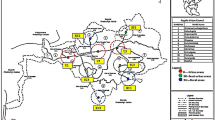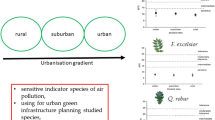Abstract
The geographic distributions of two common species of epiphytic lichens,Phaeophyscia limbata (Poelt) Kashiw. andLecanora pulverulenta Müll. Arg., on city park trees in the Osaka Plain and their relation to the distribution of SO2 and NO2 was examined. The concentrations of SO2 and NO2 are greater in the central area of this plain, and decrease with distance from the center. The frequency ofL. pulverulenta is lowest in the central area, and increases gradually toward the periphery. In contrast, the frequency ofP. limbata is highest in the intermediate area, and lower in the central and peripheral areas, i.e. at intermediate SO2 and NO2 concentrations.
We conclude thatL. pulverulenta is more useful thanP. limbata as a bioindicator of air pollutants such as SO2 and NO2.
Similar content being viewed by others
References
Hamada, N., Miyawaki, H. and Yamada, A. 1995. The substrate specificity of epiphytic lichens. Annual report of the Osaka City Institute of Public Health and Environmental Sciences57: (in press).
Hawksworth, D.L. andRose, F. 1970. Qualitative scale for estimating sulfur dioxide air pollution in England and Wales using epiphytic lichens. Nature227: 145–148.
Hawksworth, D.L. andRose, F. 1976. Lichens as Pollution Monitor. Arnold, London.
LeBlanc, F. and Rao, D.N. 1975. Effect of air pollutions on lichens and bryophytes.In J.B. Mudd and T.T. Kozlowski, eds., Responses of Plants to Air Pollution, AP, pp. 237–272.
LeBlanc, F. andSloover, J.D. 1970. Relationship between industrialization and growth of epiphytic lichens and mosses in Montreal. Can. J. Bot.48: 1485–1496.
Nakagawa, Y. andKobayashi, T. 1990. Estimation of air pollution based on the distribution and the component of epiphytic lichens by means of the modified IAP method. J. Jap. Soc. Air Pollut.25: 233–241.
Nash, T.H. 1976. Sensitivity of lichens to nitrogen dioxide fumigation. Bryologist79: 103–106.
Nash, T.H. 1988. Correlating fumigation studies with field effects.In J. Cramer, ed., Lichens, Bryophytes and Air Quality. Berlin, Stuttgart.
Sugiyama, K. 1973. Distribution ofParmelia tinctorum in urban area in Japan. Miscellania Bryologica et Lichenologica6: 93–95.
Türk, R. andWirth, V. 1975. The pH dependence of SO2 damage to lichens. Oecologia19: 283–291.
Wit, T.D. 1976. Epiphytic lichens and air pollution. J. Cramer. Vaduz.
Author information
Authors and Affiliations
Rights and permissions
About this article
Cite this article
Hamada, N., Miyawaki, H. & Yamada, A. Distribution pattern of air pollution and epiphytic lichens in the Osaka Plain (Japan). J. Plant Res. 108, 483–491 (1995). https://doi.org/10.1007/BF02344238
Received:
Accepted:
Issue Date:
DOI: https://doi.org/10.1007/BF02344238




